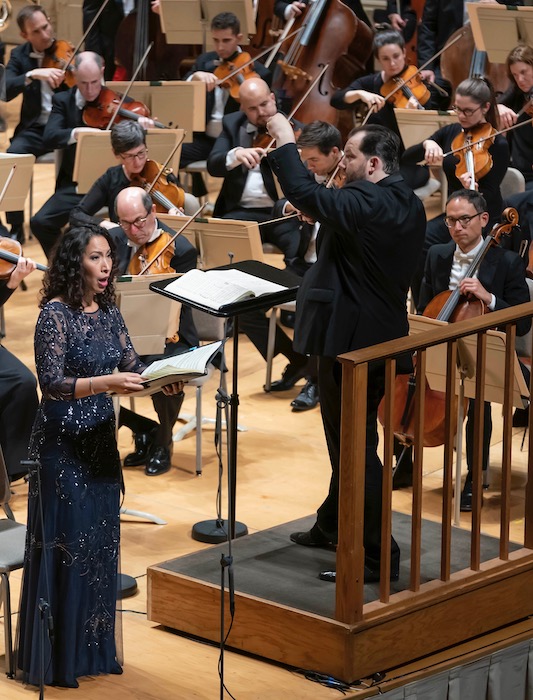A world premiere makes sure impact amid BSO’s grab-bag season opener

The concerto for orchestra has long served as a test for composers who want to leave their mark in the field of orchestral music. Following Bela Bartók‘s most famous example, composers such as Witold Lutosławski, Elliott Carter, Karel Husa, Jennifer Higdon, and Steven Stucky, among others, penned similar scores that explore the very limits of what an orchestra’s sections can do.
Eric Nathan looks to join that august company with his own Concerto for Orchestra, which Andris Nelsons and the Boston Symphony Orchestra presented in its world premiere as part of the season-opening program Thursday night at Symphony Hall.
Nathan’s music is being played more frequently around Boston in recent seasons. In 2016, the BSO premiered his spectral the space of a door. And in March 2018, the New England Philharmonic, for which Nathan now serves as composer-in-residence, presented Paestum, his evocative depiction of Greek ruins.
Like those scores, the Concerto for Orchestra is a marvel of musical logic. Commissioned by the BSO, the work lasts just 18 minutes, short by traditional standards for the genre. Yet Nathan’s music never feels as if it needs more to say.
In effect, the Concerto for Orchestra is a love letter to the BSO, an ensemble Nathan heard regularly in his youth. The opening features different sections of the orchestra in wildly varied episodes. Brasses sound out brash chords while strings supply an ethereal harmonic backdrop, like Ives’s The Unanswered Question on steroids. The melodies, played by woodwinds, are abstractions—simple rising and falling figures that ripple throughout the section.
In the score’s calm episodes, Nathan is judicious in his use of dissonance, and the smooth lines, like strong drink, offer a biting finish. The final section returns listeners to the chaos of the opening as brass and woodwinds punctuate the string figures with spiky accents. All settle into a disquieting ending, where the instrumental forces coalesce onto a unison pitch.
Leading with bold gestures, Nelsons shaped each section of Nathan’s work with an eye towards its architecture, and the orchestra answered his guidance with verve to make a strong case for this music. The BSO brass had a particularly fine outing, the section sounding out Nathan’s accents and clarion calls with seismic force. When the composer took the stage for bows, the audience showered him with enthusiastic applause.
The bulk of Thursday’s program offered a double piano concerto and a sacred work by one of the twentieth-century’s most religiously minded modernists.
Poulenc’s Gloria, heard Thursday night, was commissioned by the Koussevitzky Foundation and premiered by Charles Munch and the BSO in 1961. Though not as profound as his Stabat Mater, the Gloria evinces a sincere spiritualism that often seems twisted within a thorny harmonic framework. At 20 minutes in length, it is both solemn and profane, elements that defined Poulenc’s religious music after he reaffirmed his Roman Catholicism in 1936.
Thursday’s performance was marked by humor and austere beauty. Soprano Nicole Cabell brought her dark, soaring voice to the mysterious “Domine Deus” movements and final “Miserere nobis.” In the “Amen,” she found the uneasy peace buried within the final movement.
The Tanglewood Festival Chorus, prepared by James Burton, complemented her with a buoyant “Laudamus te” and commanding “Qui sedes.” With diction of spring-water clarity, the chorus delivered the opening “Gloria in excelsis” with both solemnity and exuberance.
Nelsons led a reading that was sensitive to the work’s wide emotional shifts. His fleet tempos also injected vitality into the music, with the “Domine fili unigenite,” the brief heart of the work, offering a particular ensemble highlight.
Poulenc’s Concerto in D minor for Two Pianos from 1932 was equally compelling. The soloists were brothers Lucas and Arthur Jussen, pianists who possess sparkling technique and graceful musicianship in equal measure.

In their hands, the music took on a live-wire intensity fit for any showpiece. Both pianists tossed off the first movement’s rippling figures with panache, bringing to the performance a level of excitement that one often encounters in heftier romantic concertos.
Nelsons navigated the orchestra and soloists through Poulenc’s mosaic-like structure, revealing several colorful twists. The movement’s second theme was searching as the pianists and conductor unfolded the lines with congenial flow. The final piano theme—the composer’s depiction of a Balinese gamelan—chimed like distant bells.
The Jussen brothers carried that sensitivity into the second movement, which took on the glow of a Mozart Larghetto. The finale brought renewed energy as the two punched out the themes with a wit that carried into the finale bars.
Beethoven’s Fantasia in C minor for piano, chorus, and orchestra, brought all the evening’s forces together.
Written as the grand finale for a December 1808 concert that included the premieres of Beethoven’s Fifth and Sixth Symphonies, the Fourth Piano Concerto, and selections from the Mass in C, the Fantasia is part concerto and part choral ode to the redemptive power of art.
Arthur Jussen’s rendering of the demanding piano part tipped more toward classical elegance than romantic bravura. Sopranos Alexandra Smither and Paulina Swierczek, mezzo-soprano Katherine Maysek, tenors Chance Jonas-O’Toole and Eric Finbarr Carey, and bass-baritone William Socolof were just as supple, rendering Christian Kuffner’s text with a svelte vocal blend. When the Tanglewood Festival Chorus entered the fray, the music took on added depth and grandeur.
Nelsons led the work with a firm sense of momentum while highlighting its many details. Principal winds and strings treated each variation with chamber-like delicacy. The March had regal pomp, and the joyous Allegro brought the work to a satisfying conclusion.
The program will be repeated 1:30 p.m. Friday and 8 p.m. Saturday at Symphony Hall. bso.org; 888-266-1200
Posted in Performances